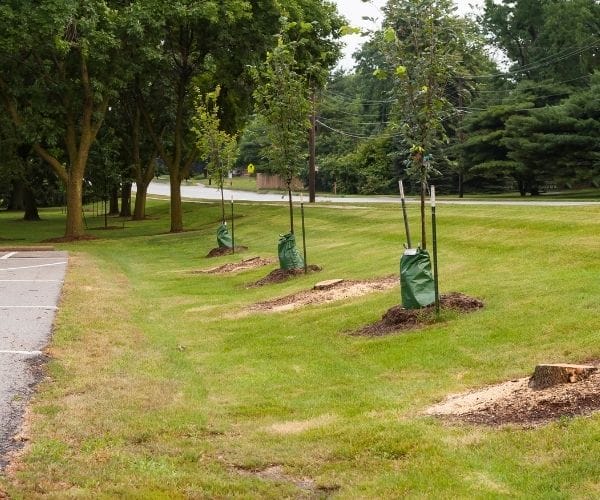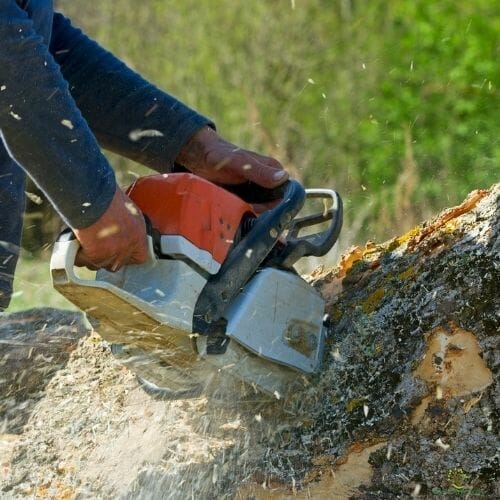Trees provide a lot of beauty to your environment, but they do need to be trimmed occasionally. Growing root systems, sick or rotting trees, dead trees, trees with compromised stability, and diseased or decaying trees can all harm your property and structure. Continue reading to find out how much tree removal costs and the criteria that influence that cost.
The Price of Tree Removal on Average
Tree removal operations can cost anywhere from $150 to $2,000, with the typical cost falling between $700 and $750. Tree removal costs vary depending on the size of the tree, with larger trees costing more to remove than smaller ones.
You might be able to get tree removal services just on budget, but make sure you hire a trained arborist who is licensed for tree removal. Even seemingly easy projects can have unanticipated issues or long-term effects, so don’t take chances with your property’s safety or the health of your landscaping.
Arborists must update their licenses on a regular basis in order to get continued training in tree removal best practices. Contact us for more information about tree removal service.
The Cost of Tree Removal is Affected by Several Factors
Large trees are more expensive to remove because they involve more heavy-duty equipment, the removal procedure is more dangerous, and there is more waste to deal with. Other aspects, however, have a role in deciding the cost of tree removal services.
Tree Size
Small trees are those that are less than 30 feet tall, with removal prices ranging from $150 to $500. Hawthornes and silver birches, for example, are small.
A medium-sized tree, such as a maple or elm, reaches 30–60 feet tall and costs $400–800 to remove. A matured oak tree can grow to be 60–80 feet tall and can cost between $700 and $1,300 to remove. The cost of removing a tree taller than 80 feet ranges between $1,000 and $2,000.
However, size isn’t the only factor to consider. Trees with thicker trunks have a tendency to grow taller. A tall tree with a thin trunk may be less expensive to remove than a tree with a broad trunk of the same height.
A tree removal company can charge you additional if a short tree has a dense trunk that is difficult to remove. Similarly, removing a tree with more than one trunk is more difficult and expensive.

Tree Type
Even if they’re distinct species, two trees of approximately the same size and trunk diameter will normally cost around the same to remove. As a result, tree size is a more reliable predictor of cost than tree type. Here’s a quick rundown of some of the most prevalent tree species.
- A matured oak tree can grow to be 60–80 feet in height and can cost anywhere from $700 to $1,300 to remove.
- The size of palm trees varies widely depending on the species, although their trunks aren’t particularly thick. As a result, removing them costs around $200 and $900.
- Because the 100+ species of pine trees can grow to be as small as five feet tall or as big as 90 feet, tree removal costs often range from $150 to $2,000.
- The cost of removing cedar trees can range from $500 to $2,000, depending on their height.
- Mature maple trees can reach heights of 60–100 feet and are normally fairly costly to remove, costing between $1,100 and $2,000 on average.
- A matured ash tree can grow to be 40–80 feet tall and can cost anywhere from $500 to $1,000 to remove.
- Poplar trees, which may reach heights of 90–115 feet and have deep root systems, are among the most costly trees to remove, costing between $1,500 and $2,000.
The Tree’s Health or Condition
A diseased tree presents a risk to the health to other trees in your lawn, your home, and anybody who enters your front yard. A tree in this condition may be less expensive to take down since it is easier to do so, but it may be more expensive if it is in a harmful location and could cause damage if it falls. To acquire a price in this case, schedule an examination with a tree removal service.
A fallen tree, on the other hand, is significantly less expensive to cut and take away than a living tree, assuming it hasn’t caused an emergency. Because a tree stump lying on the ground is considerably safer for a tree removal company to deal with, you’ll only have to spend around $100 and $300 to have it removed from your property.
Emergency Tree Removal
If a tree falls on your property or vehicle unexpectedly, or if it leans dangerously, you must remove it before it causes further harm. There will be a significant price difference between a tree removal that is scheduled a few weeks or days in advance and a tree removal that is required immediately.
You’ll have to spend more for immediate service, just like any other rush work. The job is also dangerous because the experts must be extremely cautious not to cause further damage. Tree removal costs vary greatly depending on the situation and the contractor, but they can easily exceed $5,000.
Furthermore, while contractors should never overcharge for services, you may see an increase in tree removal charges during a natural disaster, as many individuals in your region will likely want emergency tree removal.
However, before paying for this service out of pocket, check with your insurance carrier to see if your homeowner’s insurance policy would cover some or all of the expense of removing a fallen tree on your land.

Multiple Trees
You may also be able to pay per acre if you reside in a wooded region and wish to clear numerous trees. A moderately wooded region may cost between $500 and $2,500 per acre, whereas a densely wooded area could cost between $3,000 and $6,000 per acre.
Other Cost Factors
Of course, the price of tree removal isn’t just determined by the tree. Other challenging aspects could drive up the cost.
If you live in a rural area, for example, you may be charged a trip extra since the contractor will need to transport heavy equipment out to your place. Furthermore, persons who live in areas with a higher cost of living would most likely pay more for tree removal services.
Furthermore, everything that makes tree removal more difficult will raise the cost. Sloped lawns, rough or muddy soil, an angled trunk, and weak limbs are all examples of this.
If accessing or toppling the tree is dangerous—for example, if the tree is close to power lines or your home or other structures—you may be charged an additional 50% for tree removal.
Special equipment, such as cranes, must be deployed in these situations to prevent the falling tree from colliding with nearby structures. Expect to pay at least $500 more for tree removal operations that necessitate the use of a crane.
Lastly, in many regions, removing a tree taller than 10 feet necessitates obtaining a permit. While obtaining a permit is reasonably inexpensive—between $60 and $150—failing to do so before starting construction could result in a larger fine later on.
Additional Tree Services
Most homeowners, with the exception of urgent tree removal, want to remove trees as part of the broader landscaping plan. In this scenario, you might aim to explore some of the additional services offered by tree removal firms.
Instead of splitting a project into individual jobs, you may save money by hiring a business to complete it all at once. Find out more about tree stump removal & grinding services here.
Debris Removal
The price of tree removal typically includes the removal and disposal of the trunks and big branches. However, you’ll almost always be left with a lot of extra trash, which you might not want to deal with.
After all, removing debris can be costly and time-consuming if you aren’t qualified to do it. For an additional fee, certain professional tree removal firms will provide several options for debris disposal.
- Extra waste may be hauled away by a service for an additional $50 to $100.
- For your next landscaping project, a business might apply a wood chipper to transform the trash into mulch. This typically costs $75 to $125 per hour.
- Alternatively, for $75 to $100 per tree, you might have the tree and bigger branches chopped into fire logs.
Unfortunately, tree removal prices do not usually include stump removal. Some residents may like the stump’s appearance and wish to integrate it into their landscape, but the majority prefer it to be removed.
This is normally a job for a specialist professional because of the stump’s surviving root system, which may not be visible from above ground.
Depending on the duration it requires and the difficulty of the root system, removing the stump as well as its roots will likely cost between $150 and $500.
Stump grinding, which involves a hydraulic machine mulching the stump and portions of the roots, is usually a little less expensive, costing between $100 and $400.
You can also hire a stump grinder and extract the stump yourself from a hardware store. These machines, on the other hand, are primarily designed for stumps with a tiny diameter.
Burning, which costs approximately $250 per stump, and chemical treatment, which costs around $100, are two less popular techniques of stump removal.

Tree Transplanting
Consider tree relocation if you appreciate a tree in your yard but wish to relocate it to a different position on your property. The simplest trees to relocate are little trees, which might cost anywhere from $300 to $800.
Transplanting medium and large trees, on the other hand, might cost $10,000. Note that this service is not available from every tree removal business because it necessitates different equipment than basic chopping.
When Is It Possible To Chop Down a Tree Yourself?
Tree removal is usually best done by professionals most of the time, since they have the necessary equipment and training for both toppling and removing the tree.
If a tree is higher than 30 feet or within 10 feet of electricity lines, it’s not a DIY project—trying to remove a tree in these cases might result in penalties, accidents, or even lawsuit.
If you’re familiar with a chainsaw and the tree is in an open area, you might be able to tackle the job yourself with the appropriate safety equipment.
When removing a tree on your own, consider the following factors in mind:
- Even removing a small, thin fruit tree might be dangerous. Before removing a tree, ensure you have all of the appropriate protective gear, such as goggles, gloves, strong work boots, a hard hat, and hearing protection.
- Check to see if you’ll need a permit to cut down the tree.
- You will be held accountable if something bad happens and you are injured or your property is harmed.
- You may not get all the information about a tree’s condition until you check with an arborist first. If the tree is diseased or decaying, the project may quickly become more difficult.
- Remove your tree as soon as possible in the late winter or early spring, when the tree is dormant and has fewer leaves.
Generally, unless you have professional experience, we don’t encourage attempting to remove a tree greater than 10 feet. In general, the risk increases with the size of the tree. Learn how to negotiate tree removal.

















